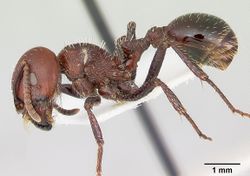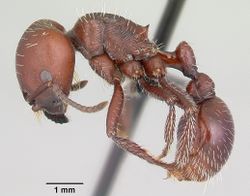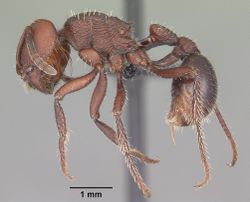Key to Pogonomyrmex workers of South American
This worker key is based on: Johnson, R.A. 2015. A taxonomic revision of South American species of the seed-harvester ant genus Pogonomyrmex (Hymenoptera: Formicidae). Part I. Zootaxa. 4029:1–142.
You may also be interested in
- Pogonomyrmex
- Pogonomyrmex species groups
- Key to Pogonomyrmecini genera and Pogonomyrmex species groups
- Clave para obreras de los generos de Pogonomyrmecini y grupos de especies de Pogonomyrmex
- Pogonomyrmex de Sur America clave a las obreras
- Key to Pogonomyrmex queens of South American
- Pogonomyrmex de Sur America clave a las reinas
1
- Fine, dense, incised striae lacking on first gastral tergum or restricted to base . . . . . 2
- Fine, dense, incised striae (usually longitudinal) cover anterior one-third to all of first gastral tergum . . . . . 23
2
return to couplet #1
- Cephalic dorsum with scattered small foveae (use >50x magnification); part to all of cephalic dorsum with fine longitudinal striae; antennal scapes short, extending beyond eye less than one-third the distance from posterior margin of eye to posterior corner of head (coarctatus-group) . . . . . 3
- Cephalic dorsum lacking foveae; cephalic dorsum with prominent longitudinal rugae or rugoreticulate; antennal scapes longer, extending beyond eye by more than one-half the distance from posterior margin of eye to posterior corner of head . . . . . 6
3
return to couplet #2
- Striae cover only part of cephalic dorsum, areas lacking striae shining to strongly shining . . . . . 4
- Striae cover entire cephalic dorsum, entire dorsum weakly shining . . . . . 5
4
return to couplet #3
- Workers usually larger, strongly polymorphic with supermajors (HW = 1.94–3.54 mm); some weak to moderately coarse transverse rugae on posterior surface of petiolar node; rugae on dorsum of postpetiole often absent, if present usually restricted to posterior margin; inferior propodeal spines lacking or very reduced in size, broadly rounded; interrugae on mesosoma finely granulate, moderately shining . . . . . Pogonomyrmex coarctatus
- Workers smaller, monomorphic (HW = 1.91–2.33 mm); coarse rugae cover posterior surface of petiolar node; weak to moderately coarse transverse rugae on dorsum of postpetiole; inferior propodeal spines present, wider than long, apex bluntly angulate to acuminate; interrugae on mesosoma not granulate, smooth and strongly shining . . . . . Pogonomyrmex marcusi
5
return to couplet #3
- In profile, lateral lobe of clypeus massively enlarged, with narrow gap (much less than width of antennal scape) between clypeal lobe and frontal lobe; concolorous ferruginous orange to orange-red . . . . . Pogonomyrmex lobatus
- In profile, lateral lobe of clypeus not enlarged with broad gap (similar to width of antennal scape) between clypeal lobe and frontal lobe; bicolored, head dark red to reddish-black, gaster blackish . . . . . Pogonomyrmex micans
6
return to couplet #2
- In frontal view, head elongate (CI < 90); hind femur long, HFI > 120; entire scape strongly striate; psammophore poorly-developed, consisting of hairs scattered over ventral side of head (cunicularius-group) . . . . . 7
- In frontal view, for most to all workers in a series head subquadrate to quadrate (CI > 90) and hind femur rarely long, HFI rarely > 100; scape smooth to moderately striate; psammophore poorly to well-. . . . . 9
7
return to couplet #6
- In profile, petiolar node rounded; inferior propodeal spines wider than high, broadly rounded; first gastral tergum smooth and polished, strongly shining; superior propodeal spines shorter than distance between their bases . . . . . Pogonomyrmex cunicularius
- In profile, petiolar node angulate; inferior propodeal spines about as wide as high, acuminate; first gastral tergum moderately to strongly coriarious, dull to weakly shining; superior propodeal spines longer than distance between their bases . . . . . 8
8
return to couplet #7
- Promesonotal dorsum weakly rugoreticulate to transversely rugose, rugae strongest on anterior pronotal dorsum; propodeal dorsum consistently transversely rugose; body concolorous tannish-red . . . . . Pogonomyrmex pencosensis
- Promesonotal dorsum coarsely and consistently rugoreticulate; propodeal dorsum rugoreticulate to transversely rugose; bicolored, mesosoma and petiolar node medium to dark orangish-brown to reddish-brown, rest of body lighter . . . . . Pogonomyrmex serpens
9
return to couplet #6
- Superior propodeal spines absent or consisting of small to moderate sized denticles or tubercles . . . . . 10
- Superior propodeal spines present, length usually >0.5x the distance between their bases . . . . . 11
10
return to couplet #9
- Dorsum of postpetiole with regular to wavy transverse rugae . . . . . Pogonomyrmex theresiae
- Dorsum of postpetiole lacking transverse rugae . . . . . Pogonomyrmex inermis
11
return to couplet #9
- Superior and inferior propodeal spines long, acuminate; in profile, posterior surface of petiolar node with crest along anterior margin; anteroventral margin of peduncle of petiole with acuminate spine; mesosoma with at least several long, flexuous hairs; anterior margin of clypeus with minute medial tooth (sylvestris-group) . . . . . 12
- Superior and inferior propodeal spines rarely long and acuminate; in profile, posterior surface of petiolar node rarely with crest along anterior margin; anteroventral margin of peduncle of petiole straight or with triangular process, but usually lacking acuminate spine; mesosoma rarely with long, flexuous hairs; anterior margin of clypeus lacking minute medial tooth . . . . . 14
12
return to couplet #11
- Larger species (HW > 1.55 mm); mandible with seven teeth; compound eye lacking hairs between ommatidia; clypeus with prominent medial carina; in profile, anterodorsal margin of postpetiole not offset from helcium . . . . . Pogonomyrmex striatinodus
- Smaller species (HW < 1.35 mm); mandible with six teeth; compound eye with hairs between ommatidia; clypeus lacking prominent medial carina; in profile, anterodorsal margin of postpetiole offset from helcium . . . . . 13
13
return to couplet #12
- Lateral surface of petiolar node longitudinally rugose; in profile, procoxae transversely striate; femur and tibiae smooth to weakly coriarious, weakly shining to shining; medial clypeal region between antennal insertions with 9–12 fine, closely-spaced, longitudinal rugae, interrugae dull to weakly shining . . . . . Pogonomyrmex stefani
- Lateral surface of petiolar node mostly smooth and shining; in profile, procoxae finely imbricate; femur and tibiae very strongly coriarious, dull; medial clypeal region between antennal insertions with 4–8 coarse, sometimes wavy, longitudinal rugae, interrugae more or less shining . . . . . Pogonomyrmex sylvestris
14
return to couplet #11
- Hairs on head (including psammophore) and mesosoma very short, maximal length similar to or slightly greater than width of cephalic interrugae (note that one to few long, coarse, stiff hairs are occasionally present along posterior margin of head and/or pronotum) . . . . . Pogonomyrmex tenuipubens
- Hairs on head (including psammophore) and mesosoma moderately long, maximal length much longer than width of cephalic interrugae . . . . . 15
15
return to couplet #14
- Dorsum of mesosoma and posterior surface of petiolar node rugoreticulate to vermiculate . . . . . 16
- Dorsum of mesosoma usually rugose, sometimes rugoreticulate to vermiculate; posterior surface of petiolar node with transverse or oblique rugae or otherwise, but never rugoreticulate to vermiculate . . . . . 17
16
return to couplet #15
- Small lobe projects dorsally from anterior margin of antennal fossa, best viewed from posterior margin of head looking down onto dorsum of lateral clypeal lobes; in dorsal view, posterior surface of petiolar node narrow, usually about as wide as distance between tips of superior propodeal spines; mesosomal hairs moderately short, longest rarely >0.7–0.8x MOD . . . . . Pogonomyrmex naegelii (in part - also #24)
- Lacking small lobe that projects dorsally from anterior margin of antennal fossa; in dorsal view, posterior surface of petiolar node broader, distinctly wider than distance between tips of superior propodeal spines; mesosomal hairs longer, longest approaching to slightly exceeding MOD . . . . . Pogonomyrmex abdominalis
17
return to couplet #15
- Dorsum of postpetiole smooth and shining, granulate, punctate, or otherwise, but lacking transverse rugae (rarely with one to few longitudinal rugae) . . . . . 18
- Dorsum of postpetiole with transverse rugae . . . . . 20
18
return to couplet #17
- Posterior surface of petiolar node lacking rugae or rarely with few weak longitudinal rugae; head and mesosoma usually concolorous dark brown to black, rarely with blackish head and orangish mesosoma; metanotal sulcus usually present, weakly to strongly impressed; inferior propodeal spines well-developed, usually acuminate; propodeal spiracles circular . . . . . P. brevibarbis-group
- Posterior surface of petiolar node with weak to moderately coarse transverse rugae; head and mesosoma concolorous light to dark ferruginous orange; metanotal sulcus rarely present; inferior propodeal spines absent to poorly-developed; propodeal spiracles narrowly ovate . . . . . 19
19
return to couplet #18
- Workers usually larger (HW = 1.75–2.05 mm); body concolorous ferruginous orange to reddish-orange; frontal lobes enlarged, lateral margins convex, projecting at a strong vertical orientation from cephalic dorsum, both in frontal view and from posterior margin of head looking down over cephalic dorsum . . . . . Pogonomyrmex bispinosus
- Workers smaller (HW = 1.24–1.61 mm); head and mesosoma concolorous ferruginous orange, gaster sometimes blackish; frontal lobes small, lateral margins subparallel, projecting nearly parallel to cephalic dorsum, both in frontal view and from posterior margin of head looking down over cephalic dorsum . . . . . Pogonomyrmex uruguayensis
20
return to couplet #17
- Deeply incised, fine, closely-spaced, regular rugae cover cephalic dorsum and mesosoma, interrugae only slightly wider than rugae; head and mesosoma black, gaster dark ferruginous orange . . . . . Pogonomyrmex mendozanus
- Rugae on cephalic dorsum coarser, wavy to slightly irregular; rugae on mesosoma irregular or rugoreticulate to vermiculate; interrugae on head and mesosoma distinctly wider than rugae; color variable, but if head and mesosoma black and gaster dark orange, then interrugae on cephalic dorsum are strongly granulate . . . . . 21
21
return to couplet #20
- Interrugae on cephalic dorsum moderately to strongly granulate, dull . . . . . P. rastratus-group (in part - also #24)
- Interrugae on cephalic dorsum smooth to moderately coriarious, weakly shining to shining . . . . . . 22
22
return to couplet #21
- Body concolorous black except for dark reddish band encircling eye; rugae on promesonotum longitudinal, usually regular; rugae at medial posterior margin of head longitudinal, rarely rugoreticulate . . . . . Pogonomyrmex tinogasta
- Head and mesosoma dark reddish-black, gaster black; rugae on promesonotum transverse, oblique, or irregular, rarely longitudinal; rugae along medial posterior margin of head usually partly rugoreticulate . . . . . Pogonomyrmex laticeps
23
return to couplet #1
- Head and mesosoma with fine, dense, deeply incised, subparallel-parallel rugae; anterior margin of clypeus with small medial tooth . . . . . Pogonomyrmex mayri
- Head and mesosoma with prominent irregular to regular, longitudinal rugae, interrugae usually wider than rugae; anterior margin of clypeus entire . . . . . 24
24
return to couplet #23
- Dorsum of mesosoma and posterior surface of petiolar node rugoreticulate to vermiculate . . . . . Pogonomyrmex naegelii (in part - also #16)
- Dorsum of mesosoma usually rugose, sometimes rugoreticulate to vermiculate; posterior surface of petiolar node with transverse or oblique rugae or otherwise, but never rugoreticulate to vermiculate . . . . . P. rastratus-group (in part - also #21)



































